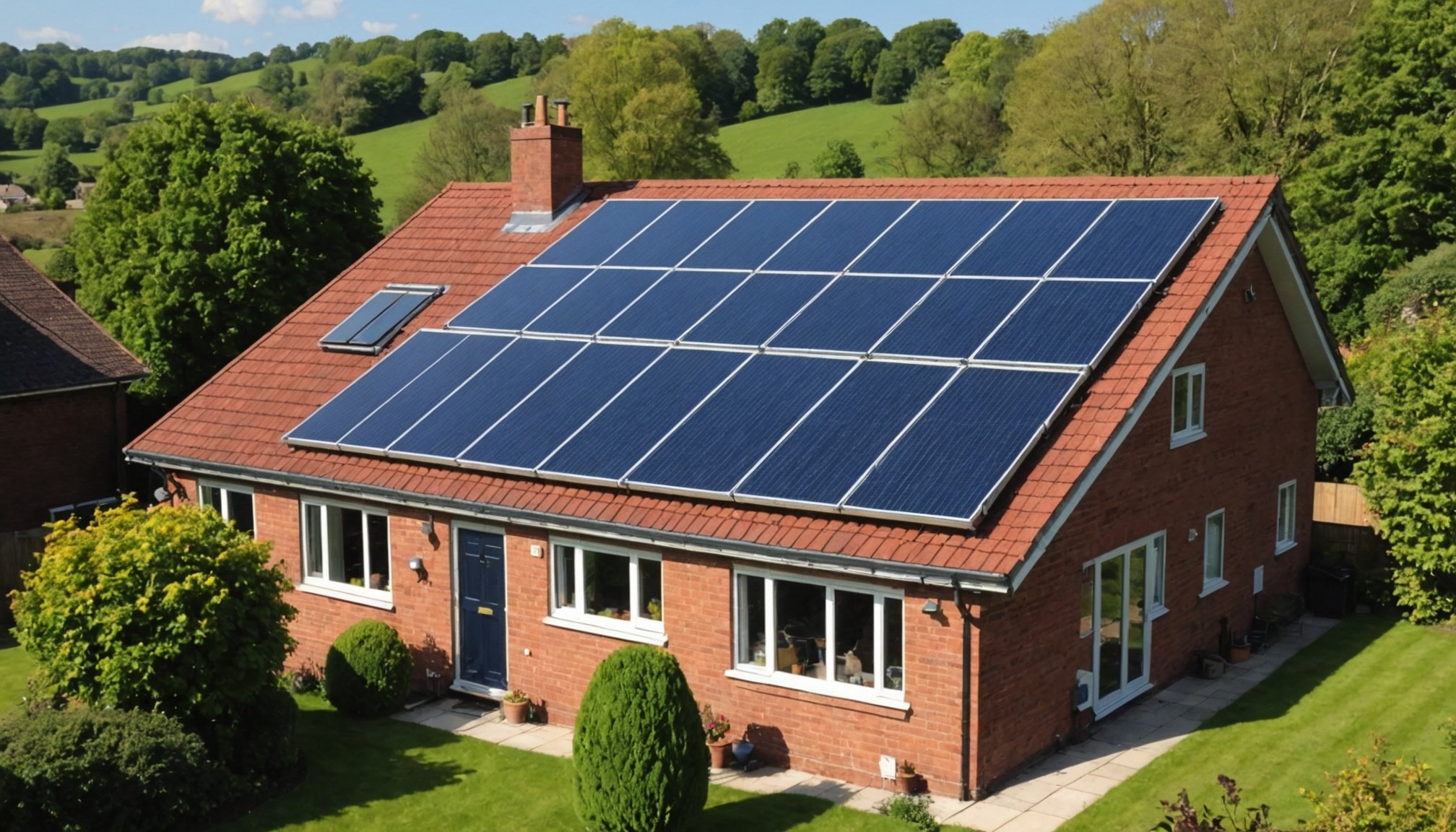Benefits of Solar Thermal Panels
Harnessing the power of the sun has numerous advantages. One of the primary benefits of solar thermal panels is significant energy cost savings. By leveraging solar power, households can reduce reliance on traditional energy sources, which contribute to fluctuating and often high electricity bills. Solar energy advantages here are twofold: not only do users save money, but they also shield themselves against the volatility of energy markets.
Furthermore, solar thermal panels offer exceptional energy efficiency. Unlike photovoltaic systems that convert sunlight into electricity, thermal panels capture solar energy as heat, achieving higher efficiency levels in heating applications. This often results in improved performance in domestic water heating, space heating, and more.
Also read : Essential Tips for UK Homeowners: Creating a Versatile Home Gym for Cardio and Strength Training
Beyond cost savings and efficiency, installing solar thermal panels benefits the environment by reducing carbon footprints. The shift from fossil fuels to clean solar energy leads to a significant decrease in greenhouse gas emissions. For eco-conscious individuals, this is a compelling reason to embrace solar solutions.
Lastly, solar thermal panels promise long-term financial incentives and a strong return on investment. Many governments offer rebates, tax credits, or grants to encourage adoption, making the initial investment more attractive. Over time, the combination of reduced energy bills and government incentives makes this a smart financial choice.
Also read : Ultimate Guide for UK Homeowners: Crafting an Efficient Backyard Composting System for Household Waste
Installation Guidelines
Embarking on a solar panel installation requires meticulous planning and adherence to specific guidelines. Initially, conduct a thorough site assessment to ensure optimal positioning of panels. This assessment should consider the roof’s angle, obstructions such as trees, and the direction that maximises sunlight exposure, typically south-facing in the UK.
The installation process usually follows a structured sequence. Begin by designing an efficient layout based on your energy needs and roof capacity. After acquiring the necessary permits, install the mounting system which secures the panels to your roof. This is followed by placing the solar panels on the mounts, ensuring they are securely fastened and angled correctly.
Solar thermal setup differs slightly, as it involves installing a heat collector that heats water directly. Similar steps apply, but pay special attention to plumbing requirements.
Finally, compliance with safety regulations and UK laws is crucial. This includes adhering to electrical safety standards and possibly consulting with local authorities for any specific building codes or laws related to solar energy systems. Thorough compliance ensures not only personal safety but also the longevity and efficiency of the system.
Compatibility with Existing Hot Water Systems
Understanding system compatibility is crucial when considering integrating solar thermal with existing hot water systems. This involves examining different types of systems and how they align with solar technology.
Types of Hot Water Systems
There are several types of hot water systems, including storage, continuous flow, and heat pump systems. Storage systems heat and store water in a tank, while continuous flow heats water on demand. Heat pumps extract heat from the air and use it to warm water. Each type has unique properties affecting its compatibility with solar thermal systems.
Assessing Compatibility
To assess system compatibility, it is essential to evaluate the existing infrastructure. Compatibility largely depends on the system design and the capacity of your current setup to accommodate solar thermal collectors. Systems with a storage tank, for instance, are generally more adaptable.
Necessary Modifications
Certain modifications may be necessary for a successful solar thermal integration. Adapting storage tanks or upsizing components might be required. The benefits include improved energy efficiency and environmental sustainability, but professional assessment is recommended to identify what changes are necessary to ensure optimal performance.
Cost Analysis
Understanding the investment involved in solar thermal costs is crucial. Initially, the cost is primarily driven by the expenses related to equipment, installation, and potential modifications to existing infrastructure. These upfront expenditures can be significant, yet they are essential for the long-term benefits solar thermal systems offer.
When conducting a financial analysis, it is essential to consider the long-term savings these systems provide. Traditional heating methods may seem cheaper upfront but can result in higher costs over time due to fluctuating fuel prices and maintenance. In contrast, solar thermal systems incur minimal operational costs post-installation, which ultimately reduces the overall expenditure.
A critical factor in evaluating return on investment is the comparison between solar thermal systems and conventional systems. Solar solutions often pay for themselves within a few years due to reduced energy bills, making them a financially wise decision over time. By reducing dependency on non-renewable energy sources, solar thermal systems offer both environmental benefits and financial advantages in the long run.
Consider these factors thoroughly to make an informed decision about integrating solar thermal technology into your energy solutions.
Government Incentives and Grants
For those considering solar thermal projects, the UK government incentives play a crucial role in reducing financial burdens. Various programs are designed to promote the adoption of renewable energy solutions, making the transition not only environmentally friendly but also financially viable.
To start, the Renewable Heat Incentive (RHI) is a noteworthy scheme. It provides financial assistance to households using solar thermal systems, thereby offsetting costs effectively. To benefit from such financial support, applicants must meet specific criteria and complete the straightforward application process. This includes registering the installation through accredited installers and proving compliance with energy standards.
In addition, grants like the Green Homes Grant offer vouchers aimed at improving energy efficiency. By applying online, homeowners can access these grants, providing significant savings on upfront costs.
These incentives dramatically influence the overall project costs, reducing the financial barrier and encouraging more widespread adoption of renewable technologies. Understanding these opportunities can empower homeowners to make informed decisions that align with both their financial considerations and environmental impact goals.
Maintenance Tips for Solar Thermal Systems
When it comes to solar thermal maintenance, regular upkeep is essential for maintaining the efficiency and longevity of your system. Key maintenance tasks include inspecting the collector surfaces for dirt and debris that could block sunlight and reducing the system’s performance. Regular cleaning should be done, especially following adverse weather conditions.
Monitoring the system’s pressure and fluid levels is another crucial upkeep tip. Low pressure may indicate a leak, while low fluid levels could suggest evaporation or leakage issues. Both scenarios require prompt investigation to prevent reduced performance or damage.
Be vigilant for signs of potential issues, such as unusual noises or decreased efficiency. These could indicate problems with the circulation pump or heat exchanger. Addressing these immediately can prevent costly repairs down the line.
Deciding between professional services and DIY maintenance can depend on your comfort level and expertise. While professional services ensure thorough inspections and repairs, simple tasks like cleaning and monitoring can often be done by homeowners. It is advisable to schedule regular professional check-ups to ensure any hidden issues are detected early. Familiarising yourself with basic system care helps optimise performance and extend the solar thermal system’s lifespan.
Case Studies of Successful Integrations
Exploring solar thermal installations provides valuable insights into homeowner experiences. This showcases how successfully integrated systems can transform energy use.
Residential Case Study 1
In Brighton, a solar thermal system was installed in a two-storey residential property. Facing space constraints, innovative solutions like roof-integrated panels maximised the solar gain. Homeowners reported a significant reduction in water heating bills, demonstrating effective energy cost savings.
Residential Case Study 2
A different story emerged from Manchester, where a new build incorporated a solar thermal installation. The project faced initial setbacks due to planning regulations. However, modifications to align with local codes ensured the system’s success. Homeowners benefited from a reliable and eco-friendly hot water supply, illustrating adaptability in installation processes.
Lessons Learned
These projects underline the importance of addressing challenges early. Key takeaways include:
- Proper panel positioning can overcome space issues.
- Compliance with local planning ensures smooth implementation.
- Homeowners’ involvement can lead to better-suited solutions.
These case studies serve as examples of adapting techniques and systems to match individual homeowner needs and constraints, paving the way for increased acceptance and adoption of solar thermal energy.











